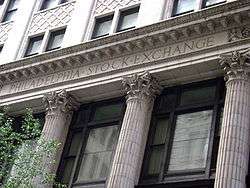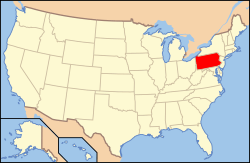Philadelphia Stock Exchange
Philadelphia Stock Exchange (PHLX), now known as NASDAQ OMX PHLX, is the oldest stock exchange in the United States. It is now owned by Nasdaq Inc. Founded in 1790, the exchange was originally named the Board of Brokers of Philadelphia,[2] also referred to as the Philadelphia Board of Brokers.[3] In 1875, the Board of Brokers changed its name to the Philadelphia Stock Exchange.
Philadelphia Stock Exchange | |
 One of the Former Locations of The Philadelphia Stock Exchange | |
   | |
| Location | 1409–11 Walnut St., Philadelphia, Pennsylvania |
|---|---|
| Coordinates | 39°56′59″N 75°09′54″W |
| Built | 1911 |
| Architect | Horace Trumbauer |
| NRHP reference No. | 82003812[1] |
| Added to NRHP | August 31, 1982 |
The exchange merged with the Baltimore Stock Exchange in 1949 and was named the Philadelphia-Baltimore Stock Exchange.[4] It merged with the Washington Stock Exchange in 1954, becoming known as the Philadelphia-Baltimore-Washington Stock Exchange (often abbreviated as PBW). In 1969, the exchange acquired the Pittsburgh Stock Exchange. In 2007, PHLX was purchased by NASDAQ for $652 million.[5]
History
1790–1875: Board of Brokers
Over its 200 years the exchange has had various titles and has been located in various buildings around Philadelphia. Founded in 1790 as the "Board of Brokers," it was located at the Merchants Coffee House, now known as the City Tavern, at the corner of Second and Walnut Streets.[6]
In 1831, Stephen Girard’s Bank had formed the "Philadelphia Merchant’s Exchange Company" to erect a new building to house the Board of Brokers and other groups. The Board of Brokers moved into the Merchants Exchange Building at 3rd and Dock Streets in 1834 following a fire at the coffee house.
On June 20, 1857, the Board of Brokers of Philadelphia transacted no business in the stock board, as their annual dinner was held that day.[2]
As of January 1, 1874, the par price for membership in the Philadelphia Board of Brokers was $1,000, with 198 seats, and "not others are attainable under $2,000 each." The board represented a market capital of around $350,000. [3]
1875–1949: Philadelphia Stock Exchange
In 1875, the Board of Brokers changed its name to the Philadelphia Stock Exchange.
In 1876, the exchange moved to the rear of the Girard Bank Building, formerly the First Bank of the United States. It stayed there until 1888. From 1888 to 1902, the exchange moved to the Drexel Building which was located near Fifth Street and Chestnut. Between 1902 and 1912, the exchange returned to the Merchants Exchange Building. In 1913, it moved to a building at 1411 Walnut Street, now a national landmark.
In 1951, the exchange moved to the Central Penn Bank Building at 1401 Walnut Street. It stayed there until 1966 when it moved to a newly constructed building (currently the Sofitel Hotel) at 17th and Sansom. The 1700 block of Ionic Street, a narrow thoroughfare just north of this building, was renamed Stock Exchange Place and was still signed as such as of 2017.
In December 1968, in response to a fiscal crisis, Philadelphia imposed a $0.05 per share stock transfer tax for all transactions on the PHLX. On January 2, 1969, the PHLX moved its trading floor to an office building, then known as the Decker Building, just across a street from the city boundaries in Bala Cynwyd to avoid the tax. In February, a court ruled that the tax was illegal, and the PHLX moved its trading floor back to its headquarters in the city.
In 1981, the exchange moved to 19th and Market, where it stayed until 2017 when it moved to its current location in the newly built FMC Tower.[7]
1949–2017: Mergers
The exchange merged with the Baltimore Stock Exchange in 1949. The exchange was then named the Philadelphia-Baltimore Stock Exchange.[4] The Baltimore Stock Exchange then migrated out of its Baltimore Stock Exchange Building, later renamed the Totman Building, to a new home base in Philadelphia.[8]
The exchange merged with the Washington Stock Exchange in 1954. The exchange was known as the Philadelphia-Baltimore-Washington Stock Exchange (often abbreviated as PBW) after those mergers. In 1969, the exchange acquired the Pittsburgh Stock Exchange, and maintained an auxiliary trading floor in Pittsburgh until 1974.
On October 22, 1981, trading was halted on both the Chicago Board of Trade and the Philadelphia Stock Exchange after anonymous callers said bombs had been placed in those buildings.
In 2005, a number of large financial firms purchased stakes in the exchange as a hedge against growing consolidation of stock trading by the New York Stock Exchange and Nasdaq. These firms—Morgan Stanley, Citigroup, Credit Suisse First Boston, UBS, Merrill Lynch and Citadel LLC—collectively owned about 89% of the exchange.
On October 20, 2007, The Wall Street Journal reported that the exchange was for sale by a group of its shareholders, and was expected to be sold for about $600 million.[9]
On November 7, 2007, NASDAQ announced a "definitive agreement" to purchase PHLX for $652 million, with the transaction expected to close in early 2008.[5] On July 24, 2008, the acquisition was completed, creating the third-largest options market in the U.S.
As of 2014, the exchange handles trades for approximately 3,600 equity options, 15 index options, and a number of FX options. The PHLX has more than 16% of United States market share in exchange-listed stock and ETF options trading.
Hours
The exchange's normal trading sessions are from 9:30 am to 4:00 pm on all days of the week except Saturdays, Sundays and holidays declared by the exchange in advance.[10]
See also
References
- "National Register Information System". National Register of Historic Places. National Park Service. January 23, 2007.
- "Annual Dinner of the Board of Brokers of Philadelphia". The New York Times. New York City, United States. June 22, 1857. p. 5. Retrieved March 21, 2017.
- "The Philadelphia Stock Board". The New York Times. New York City, United States. January 1, 1874. p. 5. Retrieved March 21, 2017.
- E. Thomas, George (March 17, 2010). The Philadelphia Stock Exchange and the City It Made. University of Pennsylvania Press. p. 235. ISBN 9780812242249.
- "NASDAQtrader.com Home Page". www.phlx.com.
- This source says 1791: Thomas Cochrane, "Philadelphia: The American Industrial Center, 1750-1850," Pennsylvania Magazine of History and Biography 106, 3 (July 1982): 327 but for 1790 see John P. Caskey, "The Philadelphia Stock Exchange: Adapting to Survive in Changing Markets," Business History Review 78, 3 (Autumn 2004): 453-54.
- "Nasdaq PHLX Trading Floor Now Open at FMC Tower". Philadelphia Magazine. April 21, 2017. Retrieved December 27, 2017.
- Foxman, Simone (July 16, 2013). "Seven things to do with superfluous trading floors". Quartz. Retrieved March 24, 2017.
- Lucchetti, Aaron (October 20, 2007). "Exchanges, Trading Firms, Consider Bids for Phil-Ex". The Wall Street Journal. Dow Jones & Company. pp. B3. Retrieved October 22, 2007.
- Market Hours, NASDAQ OMX PHLX via Wikinvest
Further reading
- Domenic Vitiello with George E. Thomas. The Philadelphia Stock Exchange and the City It Made (University of Pennsylvania Press; 2010) 256 pages
- Book Review (by Thomas J. Walsh) of The Philadelphia Stock Exchange and the City It Made (UPenn Press): http://planphilly.com/book-review-philly-stock-exchange-and-city-it-left-unfinished (www.PlanPhilly.com)
External links
| Wikimedia Commons has media related to Philadelphia Stock Exchange. |
- NASDAQ OMX U.S. Options Main Page
- PHLX Officers
- Article on PHLX history and sale
- NASDAQ OMX Group to Complete Acquisition of The Philadelphia Stock Exchange
- The Philadelphia Stock Exchange Papers, documenting the history and activities of the exchange from 1746–2005, are available for research use at the Historical Society of Pennsylvania.

